I’m actually doing a bit of catch-up here; I’ll have at least three and maybe four Bound to Blog posts up this week. Starting with:
Yep, it’s just like the teaser says: Wonder Woman in Shamrock Land. And while I love that cover — complete with bizarre scale variations, weird amorphous clover blob, bright yellow background, and a guy cut off at the waist in the best spirit of constructivist design — the story isn’t maybe as good as it might be. Part of it is the villain— the well-dressed cropped guy on the cover there. He’s called the Gentlemen Villain or something, and he’s so bland that I can’t even remember his name even though I just read the thing. He performs all the usual Marston villainy (forcing women to serve him, throwing around grenades — Marston loves grenades) but it feels pretty rote — perhaps in part because it’s mostly just in the interest of stealing stuff. I’ve seen some writing on this series that’s suggested that Marston was freed up by the end of the war…but there’s definitely something to be said for evil Nazis as enemies.
Or, you know, maybe Marston just wasn’t feeling all that inspired. Or maybe leprechauns just don’t hold that much appeal for me. I don’t know. I even felt like a lot fo the art wasn’t really all that exciting, especially compared to Peter’s ravishing work last issue.
Not that the book doesn’t have its moments. This is a great panel.
Marston definitely joins R. Crumb in having a thing for piggy-back rides. I assume it’s the masochistic implications that make it appealing for both of them; getting a piggyback is infantilizing and polymorphously (rather than explicitly sexually) intimate. WW emphasizes the mother/child aspect by calling him “funny boy” too. Their expressions are both priceless; Steve looks like his eyebrows are going to attain independent lift-off, and WW looks genuinely cranky.
Here’s a queasy moment as WW flirts with a leprechaun who has captured her:
Ick.
I like the fact that this looks more like Steve is being showered with bubbles than like he’s being buried alive:
I love the scribbly halo of WW’s lasso in this one:
And here’s the valentine day’s card. Steve has an opportunity to make WW kiss him since she’s trussed up in the lasso…and oh, she wishes he would…but he’s just too galant. It’s both romantic and fetishistic, innocent and winkingly kinky, in a way that reminds me of a certain amount of shojo:
This is a bizarre bit: are the Irish especially well known for throwing bricks? Or is this just something Marston made up?
And this is probably the best panel in the issue; I love the designs on the wall there, and the way the Princess Elaine looks impossibly diminutive. The white curved lines of the couch are really nice too; the ones to the right of Elaine almost seem like motion lines, actualy, giving the whole panel a sort of fantastical energy and motion.
The enormous bee as design element here is pretty great:
And the weird inky shadows here are very nicely done; it gives it almost a noirish feel, which is unusual for Peter (I wonder if he used a different assistant on this one or something?)
Oh, man, I’d almost forgotten the flying pigs. That pig looks so happy….
Men! They hate roses and make you sew!
Also… this is an oddly suggestive panel.
The way WW is arched with her arms thorwn back, and the energizing effects of the motion lines… And then you’ve got those weird veiny, phallic trees beneath her — we’ve definitely wandered out of Leprechaunland for a moment and into a Freudian dreamscape. And, of course, in the next panel, the excess of passion has given her amnesia. (I can’t actually remember if she’s gotten amnesia before, but it seems like a natural kink for Marston, fitting in nicely with the mind control and the dominance (fetishizing the obliteration of personality and the sense of control.))
So yeah, there’s a lot of individual things that work great; just overall it doesn’t quite fit together as well as it might. Thinking about it a little more, I think that maybe the Irish mythology just isn’t as well integrated as the Greek myths he sometimes uses, or as the more fantastic mole men or seal men or whatever settings. He seems to mostly see the Irish myths as an opportuniy for slapstick, maybe; in any case, it doesn’t jibe with his cosmic gender interests the way Mars and Venus and so forth do. The loss of the war setting also makes the whole thing seem a little directionless; instead of an epic battle between good and evil, it’s just some thieving schmo wandering around doing bad. I think the WW run really benefits from having the contrast between Marston’s set-in-stone binary crankitude and his scattershot, anything goes scripting (much the way that Peter’s art has a tension between extreme stiffness and extreme fluidity.) Marston’s ideology is certainly still present here (there’s a lot of mention of loving submission,) but it never solidifies thematically the way it does in many of the issues. But so it goes; they can’t all be gems, I guess. Hopefully Marston and Peter’ll be back on their game next issue.


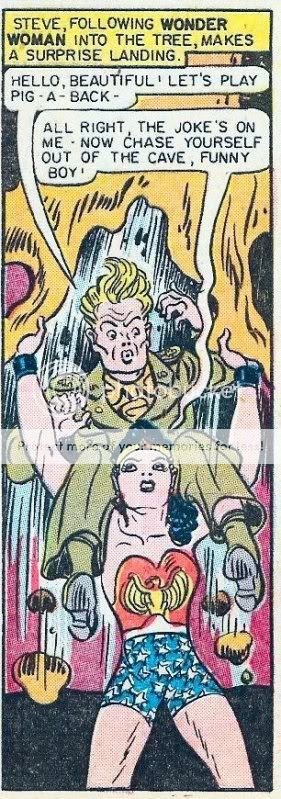
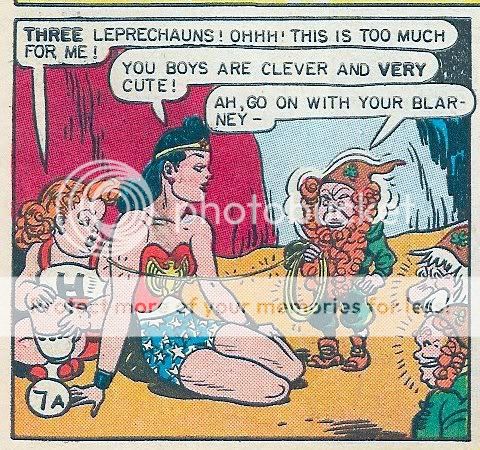
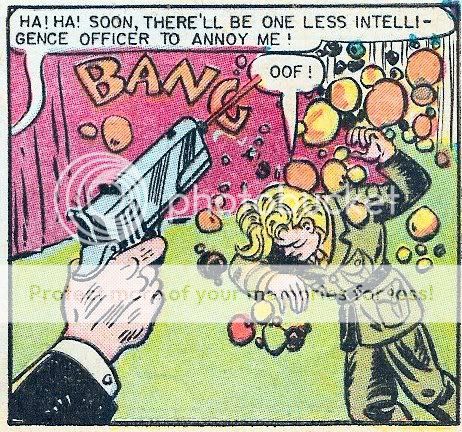



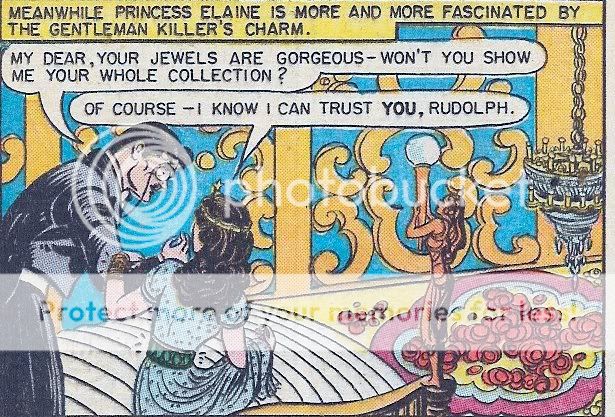

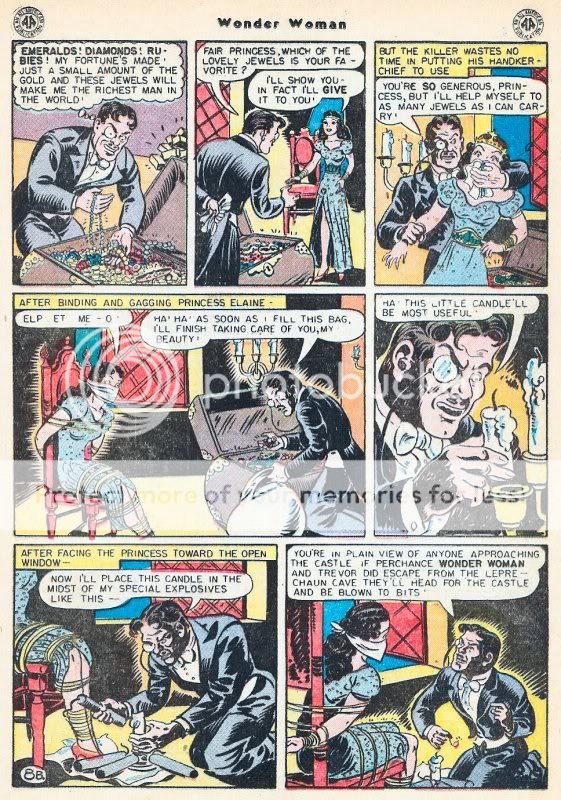
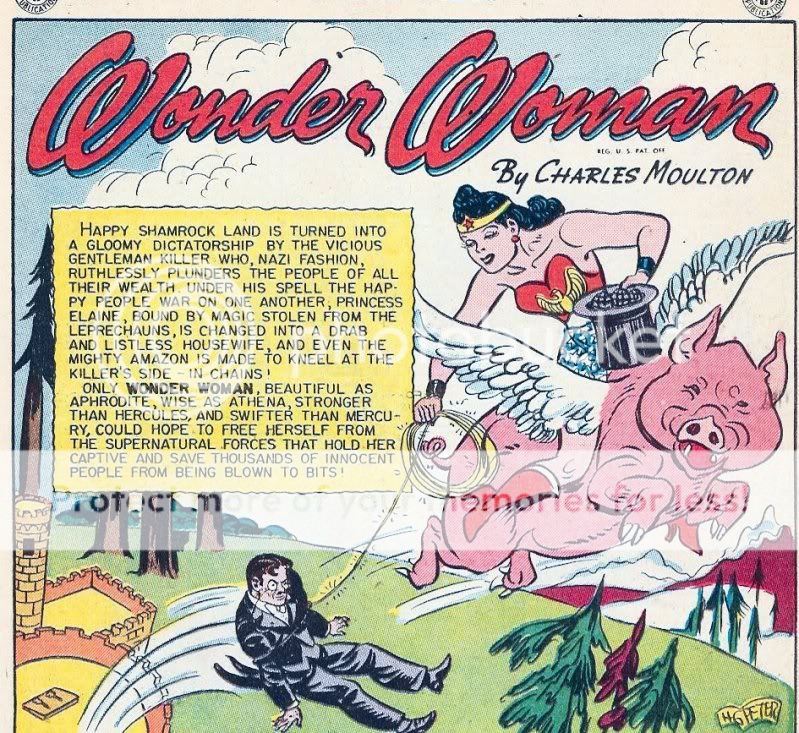

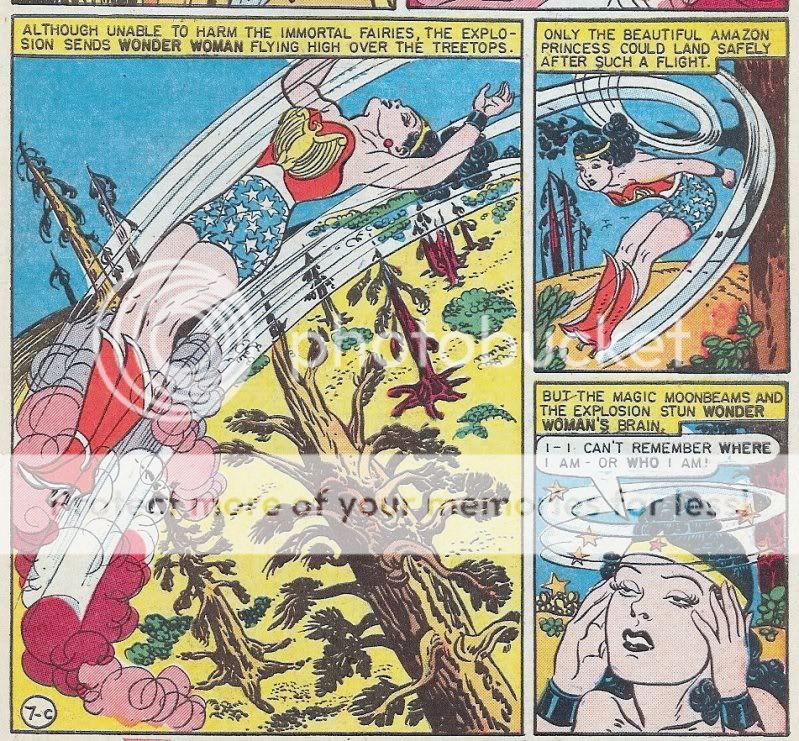
Just a guess about the brick throwing, but perhaps Marston is making a link to the idea of a stereotypical blue-collar Irish(-American) working man? Tim looks like some kind of brawny Irish laborer, with his shirtsleeves rolled up like that, and Marston would be chronologically pretty close to a time when a large number of the blue collar workers in Boston and New York (where I think he lived) were Irish. I have no idea how that would connect to Wonder Woman, though.
Layla, That seems as good a guess as any. I was wondering if there was some particular stereotype of Irish Americans as brickyard workers or something, but maybe not….
Noah,
Here are a couple of examples of the Irish bricklayer. The famed strip Bringing Up Father featured Jiggs, who won the Irish Sweepstakes and is about how he wants to go to the bar and eat corn beef and cabbage with his buddies while his social climbing wife wants to enter high society.
Wikipedia states "Strip creator George McManus was inspired by The Rising Generation, a musical comedy by William Gill that he had seen as a boy in St. Louis, Missouri's Grand Opera House, where his father was manager. In The Rising Generation, Irish-American bricklayer Martin McShayne (played by the fat Irish comedian Billy Barry in the production McManus saw) becomes a wealthy contractor, yet his society-minded wife and daughter were ashamed of him and his buddies, prompting McShayne to sneak out to join his pals for poker."
Ah ha! That's the sort of stuff. Thanks Anon!